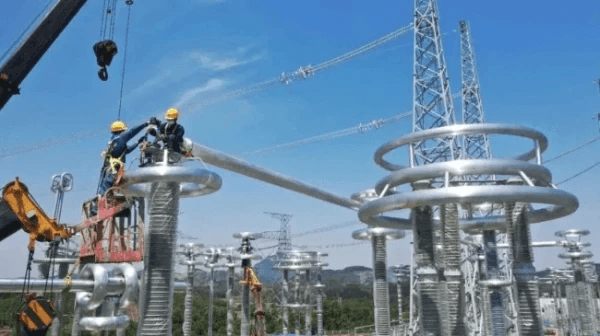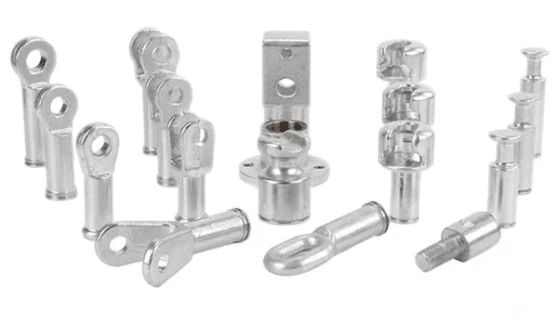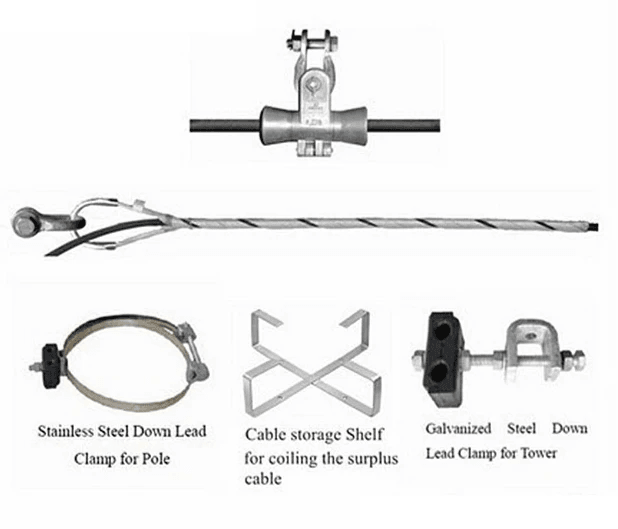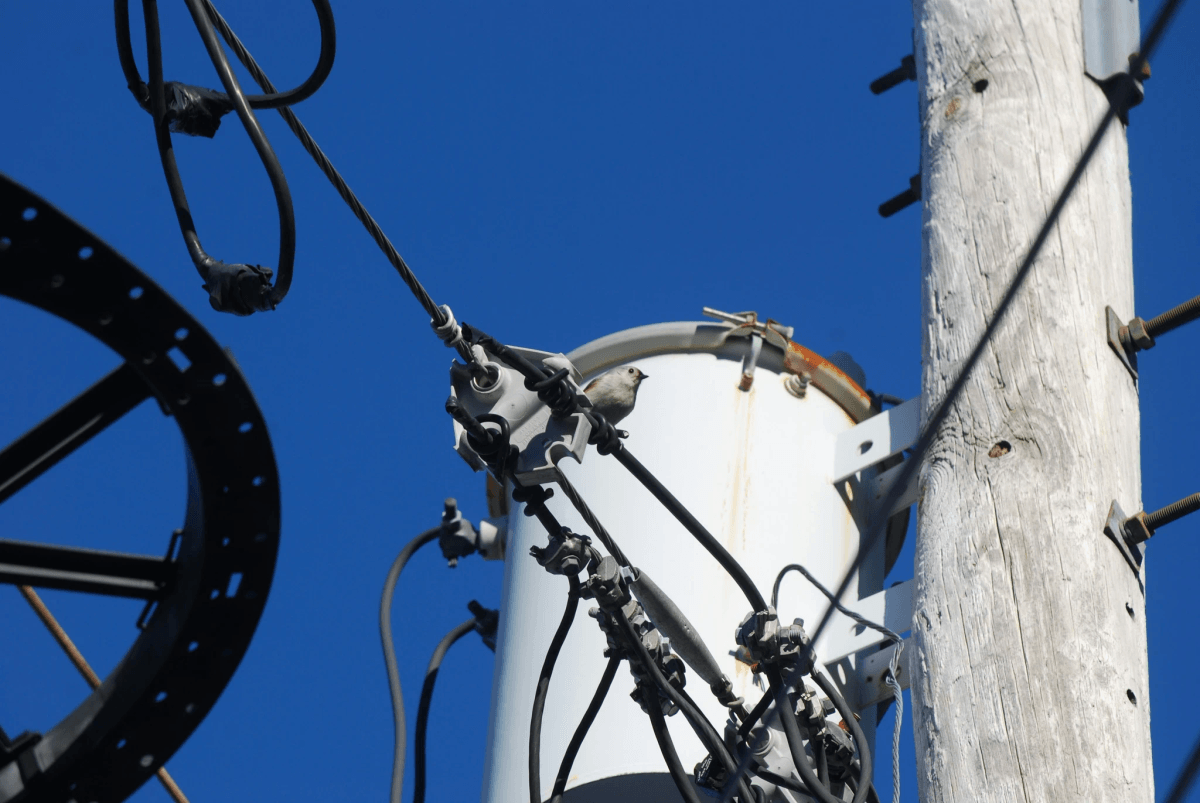Introduction

In the world of utility poles, guy wires play a crucial role in ensuring stability and safety. Understanding utility pole guy wires is essential for anyone involved in installation or maintenance, as they help support poles against various forces like wind and weight. At the heart of this support system lies the utility pole guy wire anchor, which secures these wires to the ground.
Selecting the right anchor is not just a matter of convenience; it’s vital for ensuring that your setup withstands environmental challenges. Proper anchor selection affects how well you can attach guy wire to pole structures and how effectively they perform their function. Choosing the wrong type can lead to instability, posing risks not only to infrastructure but also to public safety.
When considering a utility pole guy wire anchor, there are several top features that should guide your decision-making process. Look for anchors that offer strength and durability while being appropriate for your specific soil conditions and load requirements. Additionally, ease of installation is key; tools like a Guy Wire Anchor Kit can simplify this process significantly.
Understanding Utility Pole Guy Wires
What are guy wires for utility poles? These tensioned cables provide lateral support and help keep poles upright against external forces such as wind or ice accumulation. They are typically attached at an angle from the top of the pole down to an anchor point in the ground, creating a stable triangle structure that distributes weight effectively.
The attachment process raises another important question: How to attach guy wire to pole? This involves securing one end of the wire at specific heights on the pole using clamps or other fastening devices designed for this purpose. The effectiveness of this attachment largely depends on how well you’ve chosen your anchors since they must hold firm under stress.
Understanding what an anchor on a utility pole does is equally important—it secures the base of each guy wire, preventing it from pulling out under tension. The angle at which you anchor guy wire also matters; typically, these wires are anchored at about 45 degrees from horizontal for optimal performance. This configuration allows them to handle loads efficiently while maintaining structural integrity.
Importance of Proper Anchor Selection
Choosing an inappropriate type may lead not only to ineffective anchoring but also potential failures during storms or adverse weather conditions—definitely not something you want on your hands! Ensuring that you have made informed choices regarding your anchors is crucial for long-term success.
When considering factors such as soil type and conditions, load requirements, and angles during installation, it's clear that no two setups will be identical. The right utility pole guy wire anchor will vary based on these parameters; hence understanding them helps tailor solutions specifically suited for each situation. This knowledge helps prevent costly mistakes down the line—after all, nobody enjoys redoing work!
Additionally, proper installation techniques go hand-in-hand with selecting suitable anchors; this includes understanding common pitfalls associated with utility pole guy wire anchor installation processes. Familiarizing yourself with potential issues ensures smoother execution when deploying your anchors into place—the last thing anyone wants is an unstable setup because they overlooked critical details!
Top Features of Guy Wire Anchors
When evaluating different types of anchors available in today’s market, certain features stand out as essential components worth considering before making a purchase decision about a Guy Wire Anchor Kit or individual units themselves! First off: strength tested materials should always be prioritized—after all, if it can't hold up under pressure then what’s even its purpose?
Versatility plays another significant role here since some installations may require unique adaptations depending on environmental factors encountered throughout their lifespan outdoors! Opting for multi-functional designs could save time while ensuring reliable performance across diverse scenarios encountered by every technician working diligently behind-the-scenes!
Lastly but certainly not least—installation ease should never be underestimated either! A user-friendly design means less hassle during setup phases leading directly into successful operations thereafter without unnecessary delays hindering progress achieved thus far along project timelines established initially by teams involved throughout processes undertaken together collectively!
The Basics of Guy Wires

Understanding the fundamentals of guy wires is essential for anyone involved in utility pole installation and maintenance. These wires play a crucial role in stabilizing poles, especially in areas subject to high winds or heavy loads. Let’s dive into what guy wires are, how to attach them to poles, and the pivotal role anchors play.
What Are Guy Wires for Utility Poles?
Guy wires for utility poles are tensioned cables that provide lateral support to vertical structures such as utility poles. They help maintain the pole's stability by counteracting forces that could cause it to lean or topple over, especially during storms or high winds. Essentially, these wires ensure that power lines remain safely suspended while minimizing the risk of accidents.
How to Attach Guy Wire to Pole?
Attaching a guy wire to a pole is straightforward but requires attention to detail for proper utility pole guy wire anchor installation. Start by determining the appropriate angle at which you will anchor the guy wire; typically, this angle ranges from 30° to 45°. Once you've established your angle, use hardware like turnbuckles or clamps designed specifically for this purpose—these will secure the wire firmly without risking slippage.
The Role of Anchors on Utility Poles
Anchors are vital components in maintaining the integrity of utility pole installations; they keep guy wires taut and prevent excessive movement during adverse weather conditions. What is an anchor on a utility pole? It’s essentially a device that secures the end of a guy wire into the ground or other stable structure, ensuring that all forces acting on the pole are well-managed.
Types of Utility Pole Guy Wire Anchors

Concrete Anchors: Strength Tested
These anchors are typically installed into a concrete block or slab, providing a solid foundation that can withstand significant loads. When asking yourself What is an anchor on a utility pole?, concrete anchors answer that with robust reliability, making them ideal for high-stress environments where stability is paramount.
The installation of a concrete anchor involves digging a hole, pouring concrete, and then embedding the anchor securely within it. This method ensures that the anchor remains firmly in place while also resisting lateral forces from tensioned guy wires. If you're wondering how to attach guy wire to pole effectively using this method, remember that proper alignment at the correct angle is essential; typically around 45 degrees for optimal support.
Screw Anchors: A Versatile Choice
Screw anchors offer a flexible alternative that is particularly beneficial in various soil types and conditions. Unlike their concrete counterparts, screw anchors can be easily installed by screwing them directly into the ground without needing extensive excavation or pouring of cement. This versatility makes them an attractive option for those looking at utility pole guy wire anchor installation in areas where traditional methods may be impractical.
One advantage of screw anchors is their ability to be adjusted after installation if necessary—perfect for those moments when you need to tweak your setup! Additionally, they provide excellent holding power while minimizing soil disturbance during installation. For anyone considering what angle do you anchor guy wire with these screws, maintaining approximately 30-45 degrees will ensure maximum effectiveness while keeping your setup secure.
Deadman Anchors: Stability in Action
Deadman anchors are another ingenious solution designed specifically to provide exceptional stability in challenging environments. These consist of a buried object—often made from timber or other materials—that acts as an anchor point by distributing force over a larger area underground. When you’re exploring what are guy wires for utility poles in relation to deadman systems, think about how they offer superior resistance against pull-out forces.
Installing deadman anchors requires careful planning since they must be buried deep enough to ensure effectiveness but not so deep as to complicate future adjustments or repairs. The key here lies in their ability to remain stable even under heavy loads or adverse weather conditions—making them indispensable in areas prone to soil movement or erosion. If you're gearing up for guy wire anchor installation using deadman systems, just remember that proper placement and depth will significantly impact your setup's overall strength.
Factors to Consider in Anchor Selection

Selecting the right utility pole guy wire anchor is crucial for ensuring the stability and safety of your utility poles. Various factors come into play when making this decision, including soil type, load requirements, and the installation environment. Understanding these elements will help you choose an anchor that performs well under different conditions.
Soil Type and Conditions
The first factor to consider is the soil type and conditions where your utility pole guy wire anchor will be installed. Different types of soil—such as clay, sand, or loam—offer varying levels of support for anchors. For example, sandy soils may require deeper anchors to provide adequate resistance against pull-out forces while clay can hold anchors securely but may present challenges during installation.
Additionally, moisture content in the soil can affect its load-bearing capabilities; saturated soils are less stable than dry ones. When determining how to attach guy wire to pole effectively, it's essential to assess these factors so that your chosen anchor can withstand environmental changes over time. Remember that a thorough site evaluation will ultimately guide you in selecting the most appropriate utility pole guy wire anchor for your specific needs.
Load Requirements and Angles
Another vital consideration when selecting a utility pole guy wire anchor is understanding the load requirements and angles involved in your setup. Each utility pole has specific tension loads it must withstand based on its height, location, and purpose; thus, knowing these loads helps determine which anchors are suitable for use. For instance, if you're working with taller poles or those subjected to high wind loads, you'll need stronger anchors designed for greater resistance.
Moreover, the angle at which you install your guy wires plays a significant role in determining how effective your anchoring system will be. Generally speaking, a 45-degree angle is ideal for anchoring guy wires since it provides optimal support while minimizing lateral forces on both the pole and anchor itself. So when pondering what angle do you anchor guy wire at? Just remember: aim for that sweet spot around 45 degrees!
Installation Environment
The final factor worth considering in your search for a suitable utility pole guy wire anchor is the overall installation environment where it will be used. This includes aspects such as accessibility to installation equipment, local weather patterns (like heavy rain or snow), and potential interference from nearby structures or vegetation that could impact performance over time.
If you're working in an area with challenging terrain or limited access points, choosing a lightweight yet durable option like screw anchors may save you time and effort during installation compared to heavier concrete options requiring specialized machinery. Moreover, understanding how environmental factors influence both short-term performance and long-term stability can inform decisions about which type of Guy Wire Anchor Kit best suits your project needs.
In summary, carefully evaluating soil type and conditions alongside load requirements will ensure you choose an effective utility pole guy wire anchor suited for its intended purpose while accounting for any unique challenges posed by its installation environment.
Utility Pole Guy Wire Anchor Installation

Installing a utility pole guy wire anchor is crucial for maintaining the stability and safety of utility poles. A well-executed installation ensures that the guy wires are properly secured, preventing potential hazards caused by pole movement or collapse. In this section, we will break down the installation process into manageable steps, highlight common pitfalls to avoid, and list essential tools needed for successful utility pole guy wire anchor installation.
Step-by-Step Installation Guide
To start your utility pole guy wire anchor installation, first, gather all necessary materials and tools. Begin by determining the correct location for your anchor based on the angle at which you plan to attach your guy wire to the pole—typically between 30 and 45 degrees is optimal. Next, dig a hole according to the specifications of your chosen anchor type; for example, concrete anchors require deeper holes compared to screw anchors.
Once your hole is prepared, it's time to place the utility pole guy wire anchor securely in position. If you’re using a concrete anchor, mix and pour concrete around it as per manufacturer instructions. For screw anchors, simply twist them into place until they are firmly set in the soil.
Finally, attach your guy wire to the pole using appropriate hardware like clamps or thimbles. Ensure that everything is tightened properly; this step is crucial because loose attachments can lead to failure under load conditions. With these steps followed carefully, you can confidently secure your utility pole with a robust guy wire system.
Common Pitfalls to Avoid
When undertaking utility pole guy wire anchor installation, there are several common pitfalls that can derail even experienced installers. One major mistake is neglecting soil type assessment before choosing an anchor; different soil conditions affect anchoring effectiveness significantly. Always ensure you match your chosen method—whether it’s a deadman or screw anchor—with local soil characteristics.
Another frequent issue arises from incorrect angles when attaching guy wires; remember that an angle that's too steep can create excess tension on both the wire and its attachment points on the pole. Ideally, aim for an angle between 30 and 45 degrees when anchoring guy wires for optimal performance and safety.
Lastly, failing to use proper tools can lead to inadequate installations or even accidents during setup. Always double-check that you have all essential tools on hand before starting—this includes shovels for digging holes and wrenches or pliers for securing connections effectively.
Essential Tools for Installation
A successful utility pole guy wire anchor installation requires a specific set of tools designed for efficiency and safety during setup. First on the list is a post-hole digger or auger; these will help create precise holes suited for whichever type of anchoring system you choose—be it concrete or screw anchors.
You’ll also need various hand tools such as wrenches or ratchets equipped with sockets compatible with lag bolts used in attaching guys wires securely to poles. Additionally, having a level handy ensures that everything remains straight during installation—a tilted attachment could spell disaster later on!
Don’t forget personal protective equipment (PPE) such as gloves and safety glasses while working around heavy materials like concrete bags or metal components from your Guy Wire Anchor Kit! Keeping these essentials in mind will streamline both preparation and execution of installing those vital anchors successfully.
Exploring Guy Wire Anchor Kits

Benefits of Using a Guy Wire Anchor Kit
Using a guy wire anchor kit simplifies the process of how to attach guy wire to pole systems. These kits typically include all necessary hardware, making it easier for both professionals and DIY enthusiasts to get the job done right. Additionally, they often come with clear instructions that guide you through the installation process, ensuring that your utility pole guy wire anchor is secure and reliable.
Another significant benefit is cost-effectiveness; purchasing a kit can be cheaper than buying individual components separately. You also gain peace of mind knowing that all parts are compatible with each other, reducing the likelihood of issues during utility pole guy wire anchor installation. Plus, many kits are designed with versatility in mind, accommodating various soil types and load requirements.
Top Brands: Spark Fittings and Others
When it comes to quality products for your utility pole needs, brands like Spark Fittings stand out in the market. Known for their durable materials and innovative designs, Spark Fittings offers an array of options tailored specifically for utility pole applications. Other reputable brands also provide reliable solutions; exploring these can help you find what best suits your project.
Each brand has its unique features—some may focus on ease of installation while others emphasize strength or adaptability in different environments. Whichever brand you choose, make sure their products adhere to industry standards for safety and reliability in anchoring systems. Don't forget to check reviews or testimonials from other users; this will give you insight into their experiences with specific products.
How to Choose the Right Kit
Choosing the right guy wire anchor kit involves several considerations tailored to your specific needs—first up is understanding what are guy wires for utility poles? Knowing their function helps clarify which kit will meet your requirements effectively. Assess factors like soil type and conditions where you'll be installing; this directly impacts what angle do you anchor guy wire.
Next, consider load requirements—how much weight will your anchors need to support? The right kit should accommodate these loads while offering flexibility in installation angles and methods suited for your environment. Finally, reviewing customer feedback on various kits can guide you toward making an informed decision based on real-world performance.
Conclusion

In the world of utility pole maintenance, understanding the intricacies of a utility pole guy wire anchor is essential for ensuring stability and safety. Proper anchor selection directly influences the effectiveness of guy wires, which play a pivotal role in supporting utility poles against various environmental forces. Whether you're a seasoned professional or a DIY enthusiast, knowing how to attach guy wire to pole correctly can make all the difference in your installation process.
Key Takeaways on Anchor Selection
When it comes to choosing the right utility pole guy wire anchor, several factors should guide your decision-making process. First and foremost, consider soil type and conditions; different anchors perform better in various environments. Additionally, understanding what is an anchor on a utility pole and its load requirements will help you select an appropriate option that can withstand specific angles and tension.
As you ponder what angle do you anchor guy wire at, remember that this detail significantly impacts the overall effectiveness of your installation. Properly angled anchors ensure that forces are distributed evenly, reducing stress on both the guy wires and poles themselves. Lastly, don’t overlook the benefits of using a Guy Wire Anchor Kit; these kits often come with everything needed for successful installation while simplifying your selection process.
Final Thoughts on Installation Techniques
Utility pole guy wire anchor installation may seem daunting at first glance, but with careful planning and execution, it becomes manageable—even enjoyable! Always follow best practices when performing guy wire anchor installation to avoid common pitfalls such as incorrect angles or inadequate depth. Furthermore, familiarize yourself with essential tools that can ease the process and enhance safety during installation.
Remember that mastering how to attach guy wire to pole not only ensures structural integrity but also prolongs the life of your installations—saving time and money down the road. As you gain experience with different types of anchors like concrete anchors or screw anchors, you'll develop an intuitive sense for what works best in varying conditions. So roll up those sleeves; proper techniques lead to successful installations!
Resources for Further Learning
For those looking to deepen their knowledge about utility pole structures and maintenance techniques, there are plenty of resources available online and offline! Consider exploring instructional videos or guides focusing specifically on utility pole guy wire anchor types and their applications in real-world scenarios. Additionally, many manufacturers provide detailed manuals outlining best practices for using their products effectively.
Don’t hesitate to reach out to local professionals who specialize in utility infrastructure—they often have invaluable insights from years of hands-on experience! Joining forums or community groups dedicated to electrical infrastructure can also provide ongoing support as you navigate through your projects involving guy wires and anchors alike.

